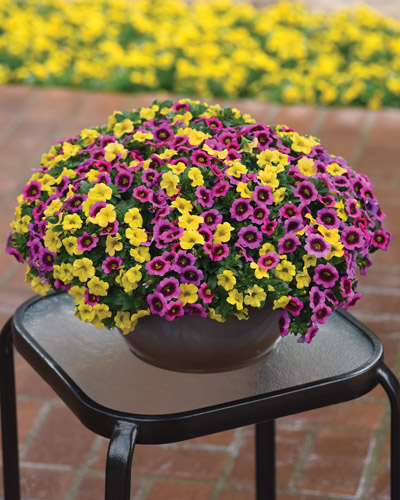12/1/2017
Finish Conga Calibrachoa with No Pinch, No PGRs
Kris Carlsson & Luís Muñoz

The introduction of the compact-growing Conga series of calibrachoa is leading the way in a new growth category in the marketplace. With applications for color bowls, component plants for mixes or window box décor, the naturally compact habit is perfect for pot-tight production and is virtually no maintenance in the greenhouse. Just stick it and forget it!
Conga is also very uniform across a wide assortment of appealing colors to attract shoppers and offers profuse flowering with superior hold at retail.
To prove it’s easy to grow even in shorter daylength and low-light conditions, we ran trials in California and Illinois with no supplemental lighting. With conclusions of both trials, we can confidently recommend a no-pinch, no-PGR finishing and provide regional recommendations so you can make the best choice for your greenhouse and climate.
California
Our quart-size target finish was Week 11 for our springtime trial in Arroyo Grande, California. Plants were stuck Week 48, with a pinch and transplant Week 1. It resulted in a Week 11 finish—that’s a 15-week crop time. The trials included B-Nine and Bonzi options, but our best practices resulted positively in the no-pinch, no-PGR regime.
PGR treatments generally delayed flowering on most varieties. However, for Conga Red—which is slightly more vigorous—we do recommend a B-Nine 2,500 ppm spray or Bonzi 1 ppm drench 6 weeks after transplant. This will tone the plant to match other Conga colors.
To produce beautiful quart-size Conga Calibrachoa, temperatures in our California greenhouse had an average daily temperature of 65F (18C). In January, we experienced about 9.5 mols per day in lighting. February saw 10.2 average daily mols, with March at 20.1 mols. That’s a lot of light during the finishing process!
Illinois
To achieve the same kind of results in the Midwest or Northeast, where there’s a lot less light in the spring, we trialed in West Chicago, Illinois, with a target finish of Week 17. Plants were stuck Week 2 with a pinch Week 5 and a transplant Week 7. It’s the same finish crop time of 15 weeks, just produced a little later in spring, which is appropriate timing for the Illinois market for calibrachoa.
The average daily greenhouse temperature in West Chicago was 69F (20C)—warmer than California! We found this force of heat helped overcome the challenge of lower light. There was almost 1/10 less light in the Midwest than on the West Coast: 1.1 mols per day in January, 4.7 mols in February and 6.9 mols in March. The results were the same: No pinch, no PGR was attainable and very low
maintenance.
However, we found in our West Chicago trial that a simple pinch two weeks prior to transplant and a B-Nine 2,500 ppm application five weeks after transplant will reduce the size of the habit, tone the plant and keep uniformity for this region.
Recommendations for Conga Red still apply in this trial, too, as it’s a more vigorous variety.
We hope these regional trials continue to help you produce the best-quality plants based on your climate and production needs. Adjust your particular Conga Calibrachoa finishing based on the temperature and lighting requirements in your area. Full culture details are available online and be sure to download both best practice trial documents at www.ballfloraplant.com. GT

Kris Carlsson is the Product Launch and Assortment Manager, and Luís Muñoz is Culture Research Technician for Ball FloraPlant. They’re stationed at the company’s Arroyo Grande, California, facility. For more culture guidelines, visit
ballfloraplant.com.